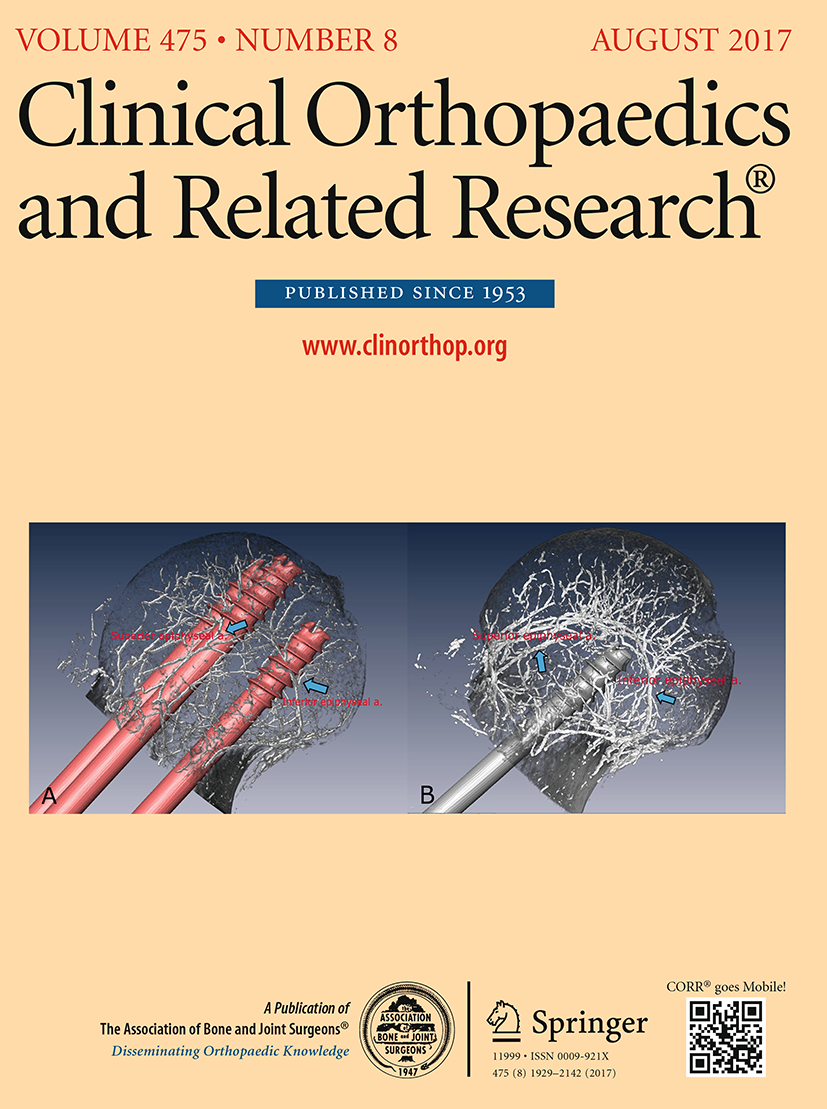
Internal fixation VS hemiarthroplasty for hip fractures produce similar outcomes at 6 yrs

Internal fixation VS hemiarthroplasty for hip fractures produce similar outcomes at 6 yrs
Randomized Trial of Hemiarthroplasty versus Internal Fixation for Femoral Neck Fractures: No Differences at 6 Years
Clin Orthop Relat Res. 2014 Jan;472(1):360-7. doi: 10.1007/s11999-013-3245-7. Epub 2013 Aug 24.Did you know you're eligible to earn 0.5 CME credits for reading this report? Click Here
Synopsis
To determine the long term efficacy of surgical hip fracture techniques, 222 patients with displaced intracapsular femoral neck fractures were randomly allocated to undergo either hemiarthroplasty or internal fixation. Outcomes including patient pain, hip function, quality of life, survival, and frequency of re-operation were measured for a minimum of 4.9 years postoperatively. An analysis of results revealed re-operations were more frequent in the internal fixation group, but no other outcome measurements significantly differed between groups at long-term follow-up.
Was the allocation sequence adequately generated?
Was allocation adequately concealed?
Blinding Treatment Providers: Was knowledge of the allocated interventions adequately prevented?
Blinding Outcome Assessors: Was knowledge of the allocated interventions adequately prevented?
Blinding Patients: Was knowledge of the allocated interventions adequately prevented?
Was loss to follow-up (missing outcome data) infrequent?
Are reports of the study free of suggestion of selective outcome reporting?
Were outcomes objective, patient-important and assessed in a manner to limit bias (ie. duplicate assessors, Independent assessors)?
Was the sample size sufficiently large to assure a balance of prognosis and sufficiently large number of outcome events?
Was investigator expertise/experience with both treatment and control techniques likely the same (ie.were criteria for surgeon participation/expertise provided)?
Yes = 1
Uncertain = 0.5
Not Relevant = 0
No = 0
The Reporting Criteria Assessment evaluates the transparency with which authors report the methodological and trial characteristics of the trial within the publication. The assessment is divided into five categories which are presented below.
4/4
Randomization
3/4
Outcome Measurements
4/4
Inclusion / Exclusion
4/4
Therapy Description
3/4
Statistics
Detsky AS, Naylor CD, O'Rourke K, McGeer AJ, L'Abbé KA. J Clin Epidemiol. 1992;45:255-65
The Fragility Index is a tool that aids in the interpretation of significant findings, providing a measure of strength for a result. The Fragility Index represents the number of consecutive events that need to be added to a dichotomous outcome to make the finding no longer significant. A small number represents a weaker finding and a large number represents a stronger finding.
Why was this study needed now?
Hip fractures are associated with significant morbidity, mortality, and healthcare costs, the consequences of which are increasing due to the aging population. Hemiarthroplasty is thought to be superior to internal fixation in the treatment of displaced femoral neck fractures within the short-term for two years postoperatively, however there is little evidence comparing these treatments over the long-term. Thus, the aim of this study was to evaluate hemiarthroplasty compared to internal fixation at longer follow-up.
What was the principal research question?
For patients over the age of 60 with a displaced intracapsular femoral neck fracture, how do internal fixation (IF) and hemiarthroplasty (HA) compare with respect to long-term pain relief, physical function and other clinical outcomes when assessed at a minimum of 5 years followup?
What were the important findings?
- At a mean of 6 years post-operatively, hip function, quality of life, and activities of daily living (ADL) did not significantly differ between groups: mean Harris hip score was 67 (SD 20) in the hemiarthroplasty group and 66 (SD 19) in the internal fixation group (p=0.96). Mean Eq5D index was 0.34 (SD 0.36) in the hemiarthroplasty group and 0.50 (SD 0.40) in the internal fixation group (p=0.10). In terms of ADL function, 51% reported good function in the hemiarthroplasty group and 42% in the internal fixation group.
- Survival did not significantly differ between the hemiarthroplasty group [37/110 patients were alive (33.6%)] and internal fixation group [33/112 patients were alive (29.5%)] after a mean of 6 years post-operation (p=0.51).
- Of the patients alive after 5-7 years, 95% (35/37) of patients in the hemiarthroplasty group still had the hemiarthroplasty while only 39% (12/31) of patients in the internal fixation group had their native hip (p<0.001).
- After 5-7 years, re-operations were required in 10% (11/110) of the hemiarthroplasty population, and in 43% (48/112) of the internal fixation population (p<0.001). Between 2-6 years, 2 patients in the internal fixation group required major re-operations: one for avascular necrosis and the other for a deep wound infection.
What should I remember most?
This study found that hip function, quality of life, and activities of daily living were similar among surviving patients after 6 years post-operatively, regardless of whether patients were treated with hemiarthroplasty or internal fixation for their intracapsular femoral neck fractures. Re-operations were significantly more frequent in the internal fixation group, with most of these re-operations occurring within the first two years post-operation.
How will this affect the care of my patients?
Hemiarthroplasty appears to achieve similar long term clinical outcomes as internal fixation for the treatment of intracapsular femoral neck fractures, with a decreased incidence of re-operations. However, results must be interpreted with caution due to a lack of statistical power attributed to excess mortality. It is recommended that future research focus on comparison of treatments in the youngest and fittest patient subgroups.
Learn about our AI Driven
High Impact Search Feature
Our AI driven High Impact metric calculates the impact an article will have by considering both the publishing journal and the content of the article itself. Built using the latest advances in natural language processing, OE High Impact predicts an article’s future number of citations better than impact factor alone.
Continue



 LOGIN
LOGIN

Join the Conversation
Please Login or Join to leave comments.